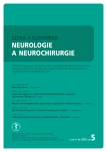Co-occurrence of the Gene ZNF9 Mutations (Myotonic Dystrophy Type 2) and Gene CLCN1 (Myotonia Congenita) in One Family – a Case Report
Authors:
O. Parmová 1,2; S. Voháňka 1,2; L. Fajkusová 2,3; K. Stehlíková 3
Authors‘ workplace:
Neurologická klinika LF MU a FN Brno
1; CEITEC – Středoevropský technologický institut, MU, Brno
2; Centrum molekulární biologie a genové terapie IHOK, FN Brno
3
Published in:
Cesk Slov Neurol N 2013; 76/109(5): 648-651
Category:
Case Report
Overview
Myotonia is delayed skeletal muscle relaxation after voluntary contraction. It is associated with impaired chloride or, less frequently, sodium channels in the muscle membrane. The chloride channel defect may be caused by a primary mutation in the skeletal muscle chloride channel gene (CLCN1) or it is secondary as in myotonic dystrophy caused by post-transcription effect of accumulated ribonucleic acid, containing expanded triplets or tetraplets of the mutated gene, on the synthesis of chloride channels. Impaired muscle relaxation that occurs in childhood dominates in patients with congenital myotonia. Clinically, the myotonia is evident and is mitigated by moderate exercise (warmup phenomenon). On the contrary, muscle weakness and systemic symptoms are prominent in myotonic dystrophy, myotonia is is less apparent. Unlike the size of the expansion (myotonic dystrophy type 1), there is no evidence that homozygous state in myotonic dystrophy would be associated with poorer clinical course or an earlier onset of the disease. We present a rare case of a patient with decontraction disorder from 33 years of age. The objective neurological finding included mild pelvic girdle muscle weakness, significant action myotonia, percussion myotonia and positive warm-up phenomenon. Molecular genetic testing confirmed myotonic dystrophy type 2 with the expansion on both alleles of the ZNF9 gene, homozygous state was supported by examination of ancestors and their relatives. Concurrently, the patient is a carrier of a mutation in the semidominate CLCN1 gene that she acquired from her mother, a carrier of heterozygous mutations in the ZNF9 gene. Homozygous phenotype of the expansive autosomal dominant gene mutations (myotonic dystrophy) generally does not lead to more severe phenotype, this condition is probably due to a concurrent mutation in chloride channels.
Key words:
myotonia – myotonic dystrophy – congenital myotonia – molecular genetics
The authors declare they have no potential conflicts of interest concerning drugs, products, or services used in the study.
The Editorial Board declares that the manuscript met the ICMJE “uniform requirements” for biomedical papers.
Sources
1. Clinical and genetic investigations of patients with myotonia congenita in Northern Norway [on-line]. Available from URL: munin.uit.no/ bitstream/ handle/ 10037/ 3993/ thesis.pdf?sequence=2.
2. Dunø M, Colding‑ Jørgensen E, Grunnet M, Jespersen T, Vissing J, Schwartz M. Difference in allelic expression of the CLCN1 gene and the possible influence on the myotonia congenita phenotype. Eur J Hum Genet 2004; 12(9): 738– 743.
3. Schoser BG, Kress W, Walter MC, Halliger‑ Keller B,Lochmüller H, Ricker K. Homozygosity for CCTG mutation in myotonic dystrophy type 2. Brain 2004; 127(8): 1868– 1877.
4. Cerghet M, Tapos D, Serajee FJ, Mahbubul Huq AH. Homozygous myotonic dystrophy with craniosynostosis. J Child Neurol 2008; 23(8): 930– 933.
5. Martorell L, Illa I, Rosell J, Benitez J, Sedano MJ, Baiget M. Homozygous myotonic dystrophy: clinical and molecular studies of three unrelated cases. J Med Genet 1996; 33(9): 783– 785.
6. The human gene mutation database [on-line]. Available from URL: www.hgmd.cf.ac.uk/ ac/ gene.php?gene=CLCN1.
7. Sedlackova J, Vohanka S, Hermanova M, Vondracek P, Fajkusova L. Analysis of the CLCN1 gene in Czech patients with myotonia congenita. Neuromuscul Disord 2009; 19: 645.
8. Neuromuscular disease center [on-line]. Available from URL: neuromuscular.wustl.edu/ mother/ activity.html.
9. Sun C, Van Ghelue M, Tranebjærg L, Thyssen F, Nilssen Ø, Torbergsen T. Myotonia congenita and myotonic dystrophy in the same family: coexistence of a CLCN1 mutation and expansion in the CNBP (ZNF9) gene. Clin Genet 2011; 80(6): 574– 580.
10. Ursu SF, Alekov A, Mao NH, Jurkat‑ Rott K. ClC1chloride channel in myotonic dystrophy type 2 and ClC1 splicing in vitro. Acta Myol 2012; 31(2): 144– 153.
Labels
Paediatric neurology Neurosurgery NeurologyArticle was published in
Czech and Slovak Neurology and Neurosurgery

2013 Issue 5
- Memantine Eases Daily Life for Patients and Caregivers
- Metamizole vs. Tramadol in Postoperative Analgesia
- Metamizole at a Glance and in Practice – Effective Non-Opioid Analgesic for All Ages
- Memantine in Dementia Therapy – Current Findings and Possible Future Applications
- Advances in the Treatment of Myasthenia Gravis on the Horizon
Most read in this issue
- Wilson Disease
- Glioblastoma Multiforme – a Review of Pathogenesis, Biomarkers and Therapeutic Perspectives
- Tumefactive Variant of Multiple Sclerosis – Two Case Reports
- The 3F Test Dysarthric Profile – Normative Speach Values in Czech
